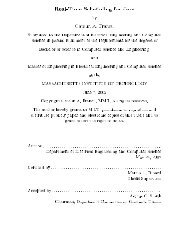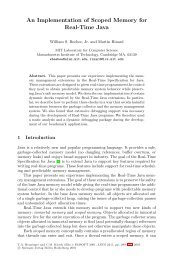HID Usage Tables Document 1.1 - C. Scott Ananian
HID Usage Tables Document 1.1 - C. Scott Ananian
HID Usage Tables Document 1.1 - C. Scott Ananian
- No tags were found...
Create successful ePaper yourself
Turn your PDF publications into a flip-book with our unique Google optimized e-Paper software.
Universal Serial Bus <strong>HID</strong> <strong>Usage</strong> <strong>Tables</strong> 32 Management OverviewThis document provides lists of usages and their descriptions that significantly extend the list of usagesprovided in the <strong>HID</strong> Specification. A <strong>HID</strong> usage communicates the intended function or meaning of aparticular control. <strong>Usage</strong>s provide a description of the data items in a <strong>HID</strong> device’s Input, Output, andFeature reports. The existence of a defined usage does not guarantee that system or application softwarewill recognize or utilize the data item. Although usages can be very powerful, there is a potential for misuse.The detail provided in this document will help minimize the misuse or misinterpretation of usages when theyare applied by a device developer.<strong>Usage</strong>s have been organized into pages of related controls. Each usage has a usage ID, usage name and adetailed description. The usage names are mnemonics, not definitions. To avoid misleading interpretationsbased on the usage name, it is very important that a developer review a usage’s description in detail toensure that it properly identifies the purpose of the control or device that the usage is attached to.In theory, a usage can be attached to any type of <strong>HID</strong> control, variable, array, collection, and so forth. Inreality, usages only make sense when they are attached to particular controls and used in certain ways. Arelatively small set of usage types have been defined to help the application software developer betterunderstand what to expect when a particular usage is found. Each usage has a usage type associated with it.The usage type identifies the item types, flag settings and bit fields organizations that are found with aparticular usage.<strong>Usage</strong>s can also identify functional devices as a whole, thus providing an easy method for an application toidentify devices that provide functions of interest. Such usages are found attached to application collectionsthat are wrapped around all the items that describe a particular functional device, or a particular function in acomplex device. Generally an application will query the <strong>HID</strong> driver for all application collection usages thatit knows pertain to it. For example, a gaming device driver might look for Joystick and Game Pad usages,while a system mouse driver might look for Mouse, Digitizer Tablet and Touch Screen usages.As a general rule, the usages selected by a device developer should be specific enough to dissuadeinappropriate use by applications while remaining general enough to allow applications to take advantage ofdevice features if they can. If uncertain, favor the more general usage to encourage broader applicationsupport for your device. An alternative is to use delimiters to define multiple usages associated with a singlecontrol or a device. For details, see Appendix B, “Delimiter Example.”Some usage pages that are in the <strong>HID</strong> Specification are also found in this document. They are included herebecause either additional text has been provided to clarify how the usages are to be used , new usages havebeen added to the page, or both. No changes have been made to the usage values assigned in the <strong>HID</strong>Specification.Version <strong>1.1</strong> April 8, 1999





